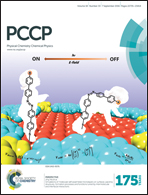Theoretical investigation of the broad one-photon absorption line-shape of a flexible symmetric carbazole derivative†
Abstract
The one-photon absorption spectrum of a carbazole derivative has been studied by employing density functional response theory combined with a mixed quantum/classical (QC) approach to simulate the spectral shape. In a first step of our analysis we employed the vertical gradient (VG) vibronic model to investigate the role of Franck–Condon (FC) profiles of the first ten electronic excited states of the system, underlying most of the range of the experimental spectrum. We then focussed on the first six excited states covering the low-energy region of the spectrum, and investigated the effect of inter-state electronic couplings on the spectral shapes within Herzberg–Teller (HT) theory. Furthermore, in order to introduce the broadening effects due to the two inter-ring torsions, we employed a QC approach, adopting VG vibronic models for high-frequency modes and computing the contribution of the torsions to the spectrum from the distribution of the excitation energies along a two-dimensional relaxed potential energy. Finally, we estimated the solvent inhomogeneous broadening by computing the solvent reorganization energy using a polarizable continuum model. Our calculations allow us to obtain a non-phenomenological description of the low-energy part of the spectrum in semi-quantitative agreement with experiment and to dissect the relative importance of solvent, torsional flexibility, FC vibronic progressions, and inter-state couplings in determining its broad spectral shapes and the modulation of its intensity. Our analysis also clearly highlights that the investigated carbazole represents a big challenge for available methodologies due to the existence of many close-lying excited electronic states coupled by internal low-frequency and high-frequency motions and by solvent fluctuations. The study of their impact on the spectra at the HT level is only approximate and more refined treatments would require a fully quantum-dynamical calculation on the manifold of the coupled states.


 Please wait while we load your content...
Please wait while we load your content...